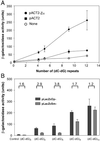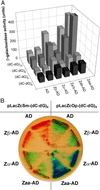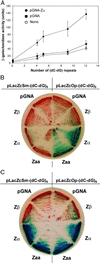Z-DNA-binding proteins can act as potent effectors of gene expression in vivo
- PMID: 12486233
- PMCID: PMC139201
- DOI: 10.1073/pnas.262672699
Z-DNA-binding proteins can act as potent effectors of gene expression in vivo
Abstract
The role of Z-DNA-binding proteins in vivo is explored in yeast. A conformation-specific yeast one-hybrid system is made in which formation of Z-DNA is studied near a minimal promoter site where it can be stabilized by negative supercoiling in addition to protein binding. Experiments were carried out with a Z-DNA-binding protein domain from the editing enzyme, double-stranded RNA adenosine deaminase 1. In the one-hybrid system, the reporter gene is activated when a Z-DNA-specific binding domain is fused with an activation domain and expressed in vivo. Significantly, it was found that even in the absence of the activation domain there is substantial transcription of the reporter gene if the Z-DNA-binding protein is expressed in the cell. This result suggests that Z-DNA formation in the promoter region induced or stabilized by a Z-DNA-binding protein can act as a cis-element in gene regulation. Related results have been found recently when the human chromatin-remodeling system converts a segment of DNA in the promoter region of the human colony-stimulating factor 1 gene into the left-handed Z-conformation.
Figures




Similar articles
-
The zalpha domain of the editing enzyme dsRNA adenosine deaminase binds left-handed Z-RNA as well as Z-DNA.Proc Natl Acad Sci U S A. 2000 Dec 5;97(25):13532-6. doi: 10.1073/pnas.240464097. Proc Natl Acad Sci U S A. 2000. PMID: 11087828 Free PMC article.
-
Double-stranded RNA adenosine deaminase binds Z-DNA in vitro.Nucleic Acids Symp Ser. 1995;(33):16-9. Nucleic Acids Symp Ser. 1995. PMID: 8643357
-
The left-handed double helical nucleic acids.Acta Biochim Pol. 2001;48(2):295-312. Acta Biochim Pol. 2001. PMID: 11732602 Review.
-
Spectroscopic characterization of a DNA-binding domain, Z alpha, from the editing enzyme, dsRNA adenosine deaminase: evidence for left-handed Z-DNA in the Z alpha-DNA complex.Biochemistry. 1998 Sep 22;37(38):13313-21. doi: 10.1021/bi9813126. Biochemistry. 1998. PMID: 9748339
-
Protein tracking-induced supercoiling of DNA: a tool to regulate DNA transactions in vivo?Bioessays. 1994 Feb;16(2):91-9. doi: 10.1002/bies.950160205. Bioessays. 1994. PMID: 8147849 Review.
Cited by
-
Transcription factor ATF-3 regulates allele variation phenotypes of the human SLC11A1 gene.Mol Biol Rep. 2013 Mar;40(3):2263-71. doi: 10.1007/s11033-012-2289-1. Epub 2012 Nov 27. Mol Biol Rep. 2013. PMID: 23187734
-
Characterization of Z-DNA as a nucleosome-boundary element in yeast Saccharomyces cerevisiae.Proc Natl Acad Sci U S A. 2007 Feb 13;104(7):2229-34. doi: 10.1073/pnas.0611447104. Epub 2007 Feb 6. Proc Natl Acad Sci U S A. 2007. PMID: 17284586 Free PMC article.
-
Evidence that vaccinia virulence factor E3L binds to Z-DNA in vivo: Implications for development of a therapy for poxvirus infection.Proc Natl Acad Sci U S A. 2004 Feb 10;101(6):1514-8. doi: 10.1073/pnas.0308260100. Epub 2004 Feb 2. Proc Natl Acad Sci U S A. 2004. PMID: 14757814 Free PMC article.
-
The C-terminal D/E-rich domain of MBD3 is a putative Z-DNA mimic that competes for Zα DNA-binding activity.Nucleic Acids Res. 2018 Dec 14;46(22):11806-11821. doi: 10.1093/nar/gky933. Nucleic Acids Res. 2018. PMID: 30304469 Free PMC article.
-
Beyond junk-variable tandem repeats as facilitators of rapid evolution of regulatory and coding sequences.Genes (Basel). 2012 Jul 26;3(3):461-80. doi: 10.3390/genes3030461. Genes (Basel). 2012. PMID: 24704980 Free PMC article.
References
-
- Liu J., Wilson, T. E., Milbrandt, J. & Johnston, M. (1993) Methods 5, 125-137.
-
- Allen J. B., Walberg, M. W., Edwards, M. C. & Elledge, S. J. (1995) Trends Biochem. Sci. 20, 511-516. - PubMed
-
- Wang A. H., Quigley, G. J., Kolpak, F. J., Crawford, J. L., van Boom, J. H., van der Marel, G. & Rich, A. (1979) Nature 282, 680-686. - PubMed
-
- Rich A., Nordheim, A. & Wang, A. H. (1984) Annu. Rev. Biochem. 53, 791-846. - PubMed
Publication types
MeSH terms
Substances
LinkOut - more resources
Full Text Sources
Other Literature Sources
Research Materials

